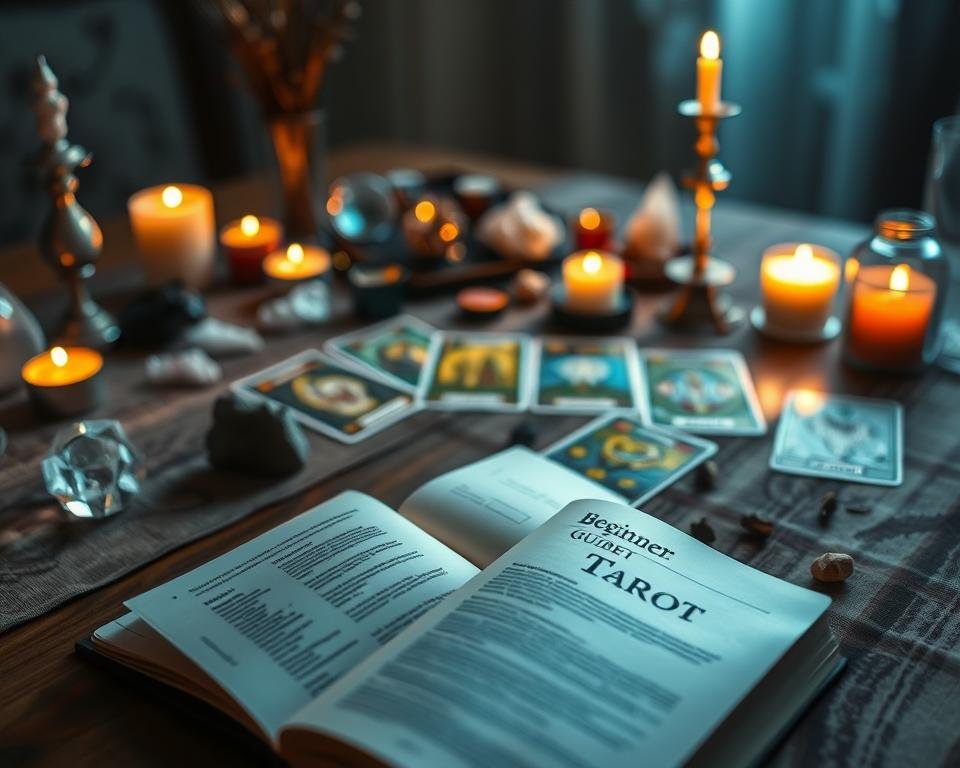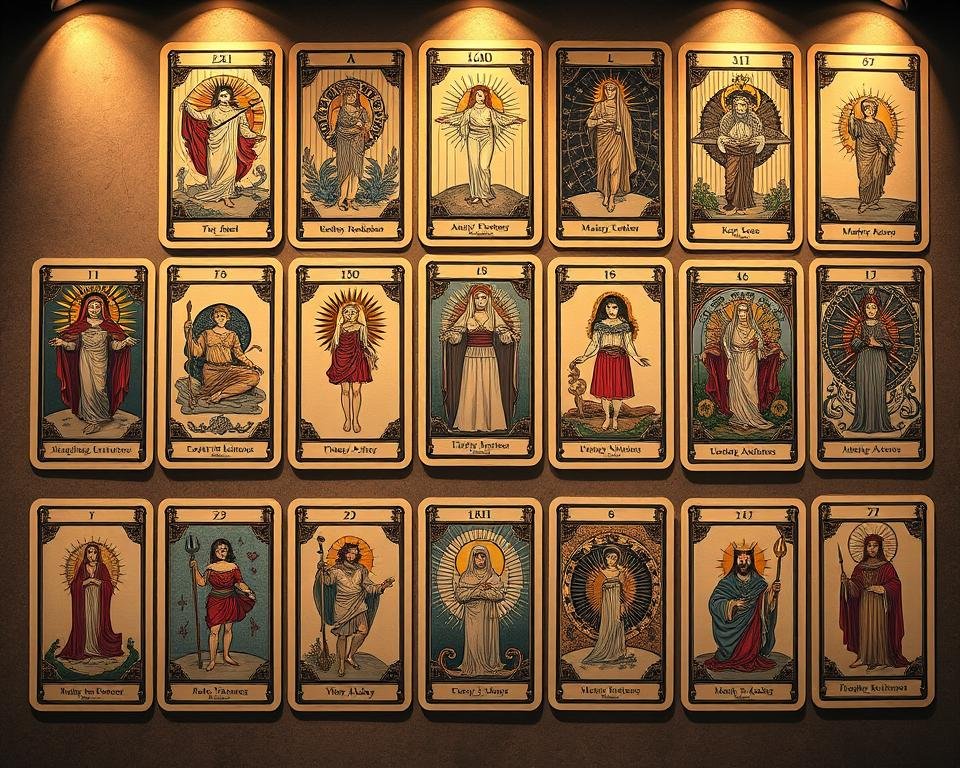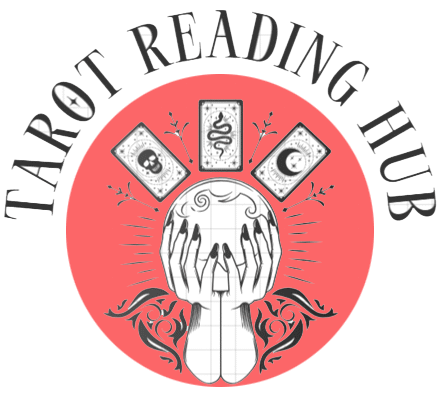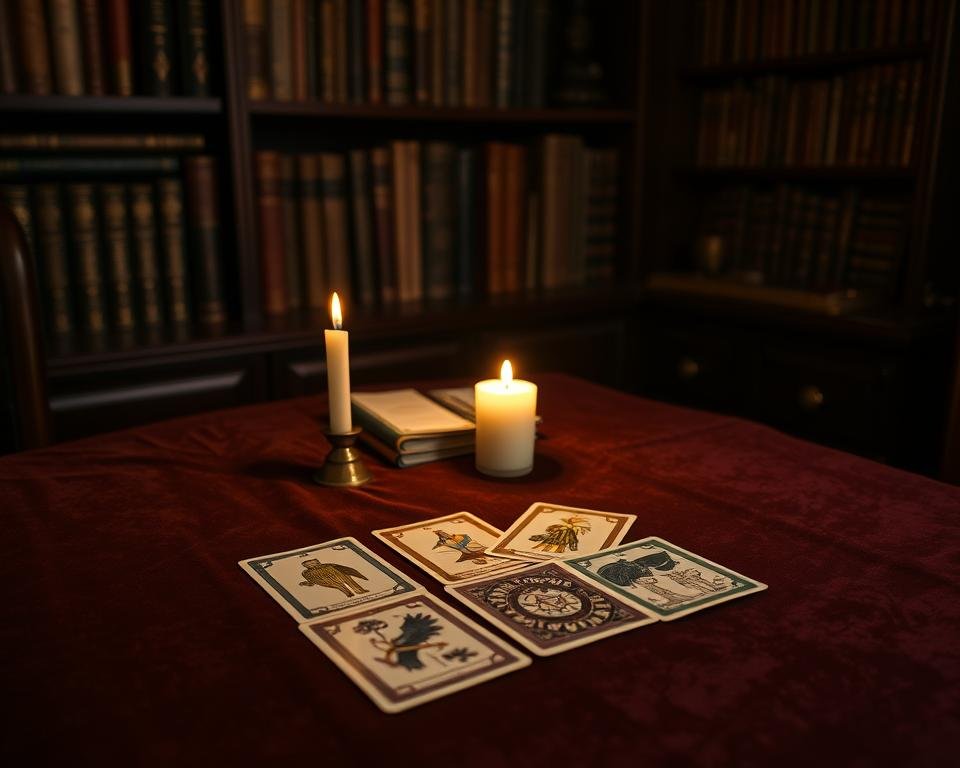Discover the world of tarot reading and unlock its potential for personal growth and self-awareness. The practice involves using a deck of cards with symbolic images to gain insight and guidance.
Using tarot cards can be a powerful tool for mindfulness and self-reflection. By understanding the basics of tarot reading, you can tap into its benefits and enhance your life.
Key Takeaways
- Understand the basics of tarot reading and its benefits
- Learn how to use tarot cards for personal growth and self-awareness
- Discover the symbolic images and their meanings
- Explore the connection between tarot reading and mindfulness
- Start your journey to self-discovery with tarot cards
The Fascinating World of Tarot Cards
The world of tarot is rich and complex, with a history that spans centuries. Tarot cards have been used for various purposes, from fortune-telling to self-reflection, and their popularity endures to this day.
The Ancient Origins and Evolution of Tarot
Tarot cards have a fascinating history that dates back to the 15th century. Originating in Italy, tarot cards were initially used for playing games. Over time, they evolved to be used for divination and self-reflection. The tarot card basics were established in the 18th century, with the introduction of the Major and Minor Arcana.
Structure of a Tarot Deck: Major and Minor Arcana
A standard tarot deck consists of 78 cards, divided into two main categories: the Major Arcana and the Minor Arcana. The Major Arcana contains 22 cards, representing significant life events and archetypes. The Minor Arcana has 56 cards, further divided into four suits, similar to a regular playing card deck. Understanding the structure of a tarot deck is essential for tarot card basics.
- Major Arcana: 22 cards representing major life themes
- Minor Arcana: 56 cards, divided into four suits (Cups, Pentacles, Swords, Wands)
Debunking Common Tarot Myths and Misconceptions
Despite its popularity, tarot reading is often surrounded by myths and misconceptions. One common myth is that tarot cards are used for fortune-telling, predicting a fixed future. In reality, tarot cards are a tool for self-reflection and guidance, helping individuals understand their current situation and potential paths forward. By understanding tarot card basics, one can dispel these myths and appreciate the true value of tarot reading.
Choosing Your First Tarot Deck
Selecting a tarot deck is more than just picking a visually appealing set of cards; it’s about finding a tool that connects with you on a deeper level. As a beginner, this choice can significantly influence your tarot journey, making it essential to choose a deck that resonates with you.

Popular Beginner-Friendly Decks and Their Unique Features
For those new to tarot, certain decks stand out for their clarity and symbolism. The Rider-Waite deck is a classic choice, known for its detailed illustrations and widely recognized symbolism. Another popular option is the Morgan-Greer deck, which offers a more contemporary take with vibrant imagery. When choosing, consider what themes or imagery resonate with you personally.
- Rider-Waite deck: Ideal for beginners due to its clear and detailed illustrations.
- Morgan-Greer deck: Offers a modern aesthetic with vivid and emotive imagery.
- Universal Waite deck: A variation of the Rider-Waite, with some modifications to the artwork.
Connecting with Your Deck: What to Look For
Connecting with your tarot deck involves more than just understanding its symbolism; it’s about feeling a personal connection. When browsing decks, pay attention to the artwork and imagery. Do the cards evoke an emotional response? Consider the guidebook that comes with the deck; a clear, concise guide can be invaluable for beginners.
Tips for connecting:
- Take time to flip through the deck, observing the imagery and symbolism.
- Read the guidebook to understand the deck’s unique interpretations.
- Hold the cards, feeling their weight and texture.
Caring for and Cleansing Your Tarot Cards
Caring for your tarot deck is crucial for maintaining its effectiveness. Regular cleansing can help clear the cards of negative energy. Methods include placing the deck in moonlight, using sage or incense, or simply shuffling the cards with intention.
Cleansing methods:
- Moonlight cleansing: Leave the deck under the full moon.
- Smudging: Use sage or palo santo to clear negative energy.
- Shuffling with intention: Focus your thoughts while shuffling to clear and reset the deck.
Tarot for Beginners: Essential Preparation Steps
Before diving into tarot readings, it’s crucial to prepare yourself and your environment. This preparation is key to unlocking the full potential of tarot card basics and ensuring a meaningful experience.
Creating Sacred Space for Your Readings
Creating a sacred space for your tarot readings is about more than just physical environment; it’s about cultivating an atmosphere conducive to introspection and connection. Choose a quiet, comfortable spot where you can sit without distractions. Consider adding elements that promote a sense of calm and spirituality, such as candles, crystals, or plants.
Grounding and Centering Techniques
Grounding and centering are essential techniques for tarot readers. They help you connect with the present moment and your inner self. Simple methods include deep breathing exercises, where you focus on the sensation of the breath moving in and out of your body, and meditation, which can help calm the mind and center your energy.
Setting Clear Intentions and Formulating Questions
Setting clear intentions and formulating specific questions are vital steps in tarot readings. Your intention could be as simple as seeking guidance or clarity on a particular issue. When formulating questions, be specific and open-ended. Instead of asking yes/no questions, ask questions that begin with « what, » « how, » or « why. » This approach encourages a deeper exploration of the tarot’s symbolism and insights.
By following these essential preparation steps, beginners can enhance their tarot reading experience, fostering a deeper connection with the cards and their own inner wisdom.
Understanding the Major Arcana Cards
For those new to tarot reading, understanding the Major Arcana cards is a crucial step in mastering the craft. The Major Arcana is a sequence of 22 cards that represent major life themes, archetypes, and transitions. These cards are numbered from 0 (The Fool) to 21 (The World), and together they tell a story of a journey through life, filled with challenges, transformations, and ultimately, fulfillment.

The Fool’s Journey Through the Major Arcana
The Fool’s Journey is a metaphorical narrative that follows the protagonist, The Fool, as he embarks on a path of self-discovery and growth. This journey is symbolic of our own life journeys, where we face challenges, make decisions, and learn from our experiences. The Fool’s Journey is a powerful tool for understanding the interconnectedness of the Major Arcana cards and how they relate to our own lives.
Some key aspects of The Fool’s Journey include:
- The beginning of the journey, represented by The Fool (0), where innocence and trust in the universe are paramount.
- The journey through various archetypes and experiences, such as The Magician (1), The High Priestess (2), and The Empress (3), each representing different facets of life and personality.
- The encounter with challenges and turning points, like The Tower (16), which signifies sudden change and revelation.
Key Symbolism and Universal Themes
The Major Arcana cards are rich in symbolism, drawing from various cultures, mythologies, and esoteric traditions. Understanding these symbols and themes is essential for interpreting the cards in a reading. Some common themes include:
« The Major Arcana cards speak to universal human experiences, transcending cultural boundaries and speaking directly to our collective unconscious. » –
- The struggle between light and darkness, represented by cards like The Sun (19) and The Moon (18).
- The cycle of life, death, and rebirth, symbolized by cards such as Death (13) and The Empress (3).
- The pursuit of knowledge and wisdom, embodied by The Hermit (9) and The Hierophant (5).
Interpreting Upright vs. Reversed Major Cards
In tarot readings, the orientation of the card (upright or reversed) can significantly influence its interpretation. Upright cards generally represent the direct or intended expression of their symbolism, while reversed cards can indicate blockages, delays, or the opposite of the usual meaning.
For example, The Empress upright might signify abundance and nurturing, while reversed, she could indicate neglect or over-nurturing. Understanding the nuances of upright and reversed interpretations is crucial for a nuanced and accurate tarot reading.
Navigating the Minor Arcana Suits
For those new to tarot reading, the Minor Arcana suits are an essential area of study, providing a deeper understanding of the cards. The Minor Arcana is composed of four suits, similar to a regular playing card deck, but with its own unique symbolism and interpretations.
The Four Elements: Cups, Pentacles, Swords, and Wands
The four suits of the Minor Arcana correspond to different elements and aspects of human experience. Cups are associated with emotions and relationships, Pentacles with material possessions and career, Swords with thoughts and communication, and Wands with creativity and action.
- Cups: Representing emotions, Cups can indicate emotional states, relationships, and intuitive insights.
- Pentacles: Associated with the physical realm, Pentacles can signify financial matters, career, and practical decisions.
- Swords: Symbolizing the realm of thoughts, Swords can represent mental clarity, decisions, and communication.
- Wands: Embodying creativity and energy, Wands can indicate inspiration, passion, and taking action.
Court Cards and Their Personality Traits
Court Cards in the Minor Arcana represent different personalities and roles that we may encounter or embody. These cards can offer insights into people’s characteristics, behaviors, and how they interact with us.
The Court Cards are typically divided into four categories: Page, Knight, Queen, and King. Each category has a unique energy and can represent different aspects of ourselves or others.
- Page: Often represents curiosity, messages, or a youthful energy.
- Knight: Typically signifies action, adventure, or a romantic/charismatic approach.
- Queen: Embodies nurturing, care, and feminine energy, often representing a supportive figure.
- King: Represents authority, leadership, and masculine energy, often signifying a wise or authoritative figure.
Number Cards and Their Progressive Meanings
The Number Cards, ranging from Ace to Ten, tell a story of progression and development within each suit. Understanding the sequence and the themes associated with each number can deepen your tarot reading skills.
For example, Aces represent new beginnings, while Tens signify completion or fulfillment. As the numbers progress, they indicate different stages of a journey or process, offering insights into challenges, decisions, and outcomes.
- Ace to Four: Represents the initial stages of a project or situation, including planning and laying foundations.
- Five to Seven: Indicates challenges, changes, and evaluations that lead to growth.
- Eight to Ten: Signifies nearing completion, making final decisions, and achieving outcomes.
By understanding the Minor Arcana suits, Court Cards, and Number Cards, beginners can enhance their tarot reading skills, gaining a more nuanced understanding of the cards and their symbolism. This foundation is crucial for tarot reading for beginners, as it allows for more accurate and meaningful interpretations.
Essential Tarot Spreads for Beginners
Beginners can greatly benefit from learning essential tarot spreads, which serve as a foundation for more complex readings. Tarot spreads are predefined layouts of cards that help guide the interpretation process, providing a framework for answering specific questions or understanding different aspects of a situation.
Starting Simple: One-Card Daily Draws
One of the simplest and most effective tarot spreads for beginners is the one-card daily draw. This involves drawing a single card each day to gain insight into the day’s energies or themes. It’s an excellent way to develop a daily tarot practice, helping you become more attuned to the cards and their symbolism. To perform a one-card draw, simply shuffle your deck, cut it at a random point, and draw the top card. Reflect on the card’s meaning and how it might relate to your day ahead.
Tips for a one-card draw:
- Keep a tarot journal to record your daily draws and reflections.
- Consider the card’s position in relation to your question or the day’s theme.
- Use the card as a focal point for meditation or contemplation.
Three-Card Spread Variations for Different Questions
The three-card spread is another versatile and popular layout for beginners. It typically represents past-present-future, situation-challenge-outcome, or mind-body-spirit. This spread can be adapted to answer a wide range of questions by adjusting the interpretation of each card’s position. For example, you can use it to understand a relationship dynamic, explore career decisions, or gain insight into personal growth.
Example of a three-card spread:
- Past influences: The first card represents the energies or events that have led to the current situation.
- Present situation: The second card reflects the current state of affairs.
- Future outcome: The third card indicates the potential outcome based on the current trajectory.
The Five-Card Spread for Deeper Insight
For those looking to delve deeper into a specific question or situation, the five-card spread offers more detailed insights. This spread can be arranged in various patterns, such as a cross or a circle, with each position representing a different aspect of the query. A common configuration is:
- Center card: The current situation or main theme.
- Top card: The challenge or obstacle.
- Bottom card: The underlying influence or subconscious factor.
- Left card: The past influence or how the situation has developed.
- Right card: The future outcome or direction.
By exploring these essential tarot spreads, beginners can develop a solid foundation in tarot reading, enhancing their understanding of the cards and their ability to interpret them in various contexts.
Conducting Your First Complete Tarot Reading
The journey of conducting your first complete tarot reading is not just about predicting the future; it’s about understanding the present and gaining insight into your current situation. As you embark on this path, you’ll discover that tarot reading is a powerful tool for self-reflection and personal growth.
Step-by-Step Reading Process from Start to Finish
To conduct a successful tarot reading, follow a step-by-step process. Begin by preparing your space and creating a conducive environment for the reading. Next, shuffle the cards while focusing on the question or area of your life you seek guidance on. Once you’ve laid out the cards in your chosen spread, take a moment to synthesize the overall impression before interpreting individual cards.
The actual reading involves interpreting the cards in relation to their position in the spread and their interaction with each other. This step requires patience and practice, as the meaning of each card can be influenced by its context within the reading.
Interpreting Card Combinations and Relationships
Understanding how cards interact with each other is crucial in tarot reading. The relationship between cards can provide deeper insights into the question or situation being explored. For instance, the combination of a Major Arcana card with a Minor Arcana card can indicate a significant life event or turning point. Paying attention to these combinations and their symbolic connections can enrich your understanding of the reading.
Ethical Considerations When Reading for Yourself and Others
When conducting tarot readings, it’s essential to consider the ethical implications of your practice. This includes being mindful of the impact your readings can have on others and ensuring that you’re not using the tarot to manipulate or control. When reading for yourself, be honest with yourself about your motivations and the questions you’re seeking answers to. Remember, the tarot is a tool for guidance, not a definitive predictor of the future.
By being aware of these ethical considerations and approaching tarot reading with sensitivity and respect, you can create a safe and beneficial experience for yourself and others.
Developing Your Unique Intuitive Reading Style
The key to unlocking the true potential of tarot lies in trusting your intuition and developing a personal reading style. As you progress on your tarot journey, you’ll find that your ability to interpret the cards evolves from merely memorizing meanings to having a more intuitive and personal connection with the deck.
Trusting Your Intuition Over Memorized Meanings
While understanding the traditional meanings of tarot cards is essential, it’s equally important to learn to trust your intuition. Intuition allows you to make connections between the cards and the querent’s situation that go beyond the literal interpretation. To cultivate this, try to focus on the overall impression the cards give you, rather than just their individual meanings.
Keeping a Tarot Journal to Track Your Progress
Keeping a tarot journal is a powerful tool for tracking your progress and deepening your understanding of the cards. Write down your readings, note your impressions, and reflect on the outcomes. This practice will help you identify patterns and themes in your readings, enhancing your intuitive abilities.
Practical Exercises to Strengthen Your Tarot Skills
To further develop your tarot skills, try simple exercises like drawing a card a day and interpreting it intuitively. Practice different spreads and pay attention to how the cards interact with each other. The more you practice, the more your intuition will guide you in delivering meaningful and accurate readings.
Conclusion: Embracing Your Tarot Journey
As you conclude this introduction to tarot card basics, you are now poised to embark on a fascinating journey of self-discovery and insight. The world of tarot offers a wealth of knowledge, and the skills you’ve gained so far are just the beginning.
By understanding tarot card basics, you’ve taken the first step towards unlocking the secrets of the tarot. As you continue to explore and deepen your practice, remember to stay open to the insights and guidance that tarot offers.
Your tarot journey is unique, and it’s essential to be patient and compassionate with yourself as you navigate the ups and downs. With consistent practice and a willingness to learn, you’ll find that tarot becomes a valuable tool for personal growth and introspection.



